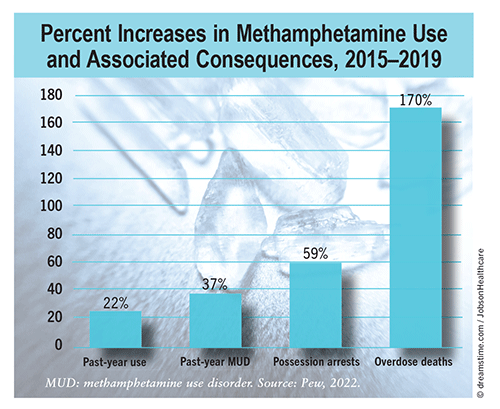US Pharm. 2023;48(5):14.
Methamphetamine is a highly addictive psychostimulant that may be ingested, injected, snorted, or smoked to produce a short and intense “rush.” Long-term misuse can lead to anxiety, insomnia, mood disturbances, and violent behavior. Methamphetamine has also been implicated in a number of overdose deaths, especially with continuing increases in the recreational use of multiple substances and the contamination of drug supplies with highly potent fentanyl. Recent data from the National Institute on Drug Abuse (NIDA) highlight the need for public-health approaches focused on addressing methamphetamine use among individuals with the highest risk for misuse and across diverse communities and underserved areas nationwide.

Methamphetamine Use: In a study conducted by the NIDA, methamphetamine use among U.S. adults aged 18 to 64 years was evaluated between 2015 and 2019. Frequent use of methamphetamine (>100 days per year) increased by 66% and use of methamphetamine with cocaine increased by 60% during this time. A 22% increase in any methamphetamine use was also noted. Between 2017 and 2019, adults who reported methamphetamine use in the past year described higher-risk use patterns (i.e., having methamphetamine use disorder [MUD] and/or injecting methamphetamine). These findings may help explain the increased number of methamphetamine-associated overdose deaths during the same time period.
Methamphetamine Use Disorder: In the U.S., methamphetamine use and MUD have historically been most common among middle-aged white adults. Between 2015 and 2019, the prevalence of MUD without injection of the drug quadrupled in young adults (ages 18-23 years); more than doubled among heterosexual, homosexual, or bisexual men; more than tripled among heterosexual, homosexual, or bisexual women; more than doubled among Hispanic adults; nearly tripled among white adults; and increased 10-fold among black adults. Prevalence of MUD with injection of the drug was highest among homosexual men and American Indians/Alaska Natives. Currently, there are no FDA-approved medications to treat MUD or help minimize associated consequences, such as overdose deaths.
Overdose Deaths: According to the most recent provisional data from the CDC National Center for Health Statistics, more than 1 million people in the U.S. have died from a drug overdose since 1999. Age-adjusted rates of drug-overdose deaths per 100,000 population for psychostimulants with abuse potential (primarily methamphetamine) increased from 0.2 in 1999 to 5.0 in 2019. Between 2015 and 2019, methamphetamine-associated overdose deaths tripled among U.S. adults. American Indians/Alaska Natives were found to have the greatest increases in methamphetamine-associated overdose deaths. In 2020 and 2021, drug-overdose deaths associated with the use of psychostimulants that have abuse potential (primarily methamphetamine) continued to increase, as did age-adjusted rates of associated overdose deaths (7.5 and 10.0 per 100,000 population, respectively).
The content contained in this article is for informational purposes only. The content is not intended to be a substitute for professional advice. Reliance on any information provided in this article is solely at your own risk.
To comment on this article, contact rdavidson@uspharmacist.com.





